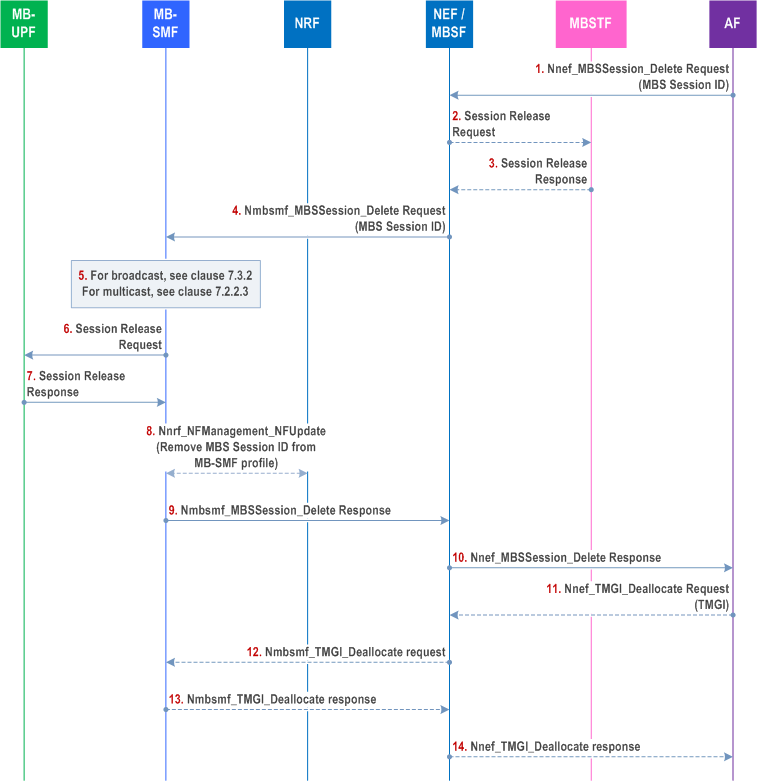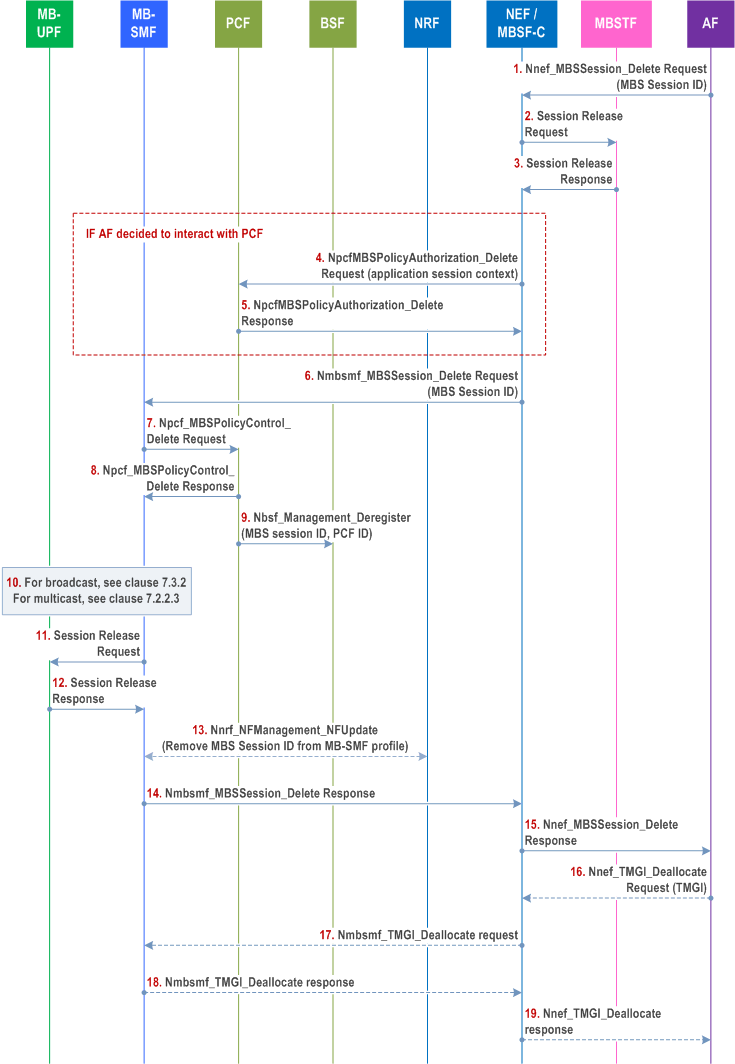Content for TS 23.247 Word version: 18.6.0
1…
4…
4.2…
4.3
5…
6…
6.6…
7…
7.1.1.2
7.1.1.3
7.1.1.4…
7.1.1.6…
7.1.2…
7.2…
7.2.2…
7.2.3…
7.2.4…
7.2.4.3…
7.2.5…
7.2.6…
7.3…
7.3.5…
7.5…
8…
9…
9.2…
9.3…
9.4…
A…
7.1.1.4 MBS Session Deletion without PCC p. 54
This procedure is used by the AF to delete the MBS Session. This procedure may also include TMGI de-allocation. The procedures apply to both multicast and broadcast communications unless otherwise stated. This procedure releases the reserved resources in both 5GC and NG-RAN.

Step 1.
AF of content provider may request to delete the MBS session (MBS Session ID).
Step 2/3.
If an MBSTF was inserted into the user plane, the MBSF request the MBSTF to release user plane resources.
Step 4.
NEF/MBSF requests MB-SMF to delete resources for the MBS session.
Step 5.
For Broadcast MBS session, the MB-SMF triggers resource release towards the AMFs as specified in clause 7.3.2. For Multicast MBS session, the MB-SMF triggers resource release towards the SMFs as specified in clause 7.2.2.3.
Step 6/7.
MB-SMF requests the MB-UPF to release user plane resources.
Step 8.
[Conditional] If MB-SMF configured the profile with an MBS Session ID when the MBS session was created, the MB-SMF updates its NF profile at NRF to release the MBS Session ID.
Step 9.
MB-SMF responds to the NEF/MBSF.
Step 10.
The NEF/MBSF responds to the AF.
Step 11.
[Optional] AF requests NEF/MBSF to de-allocate TMGI(s),
Step 12.
[Conditional on step 11] NEF/MBSF forwards request to de-allocate TMGI(s) to MB-SMF.
Step 13.
[Conditional on step 12] The MB-SMF responds to the NEF or MBSF by sending a de-allocate TMGI Response message.
Step 14.
[Conditional on step 13] NEF or MBSF forwards de-allocate TMGI Response message to AF.
7.1.1.5 MBS Session Deletion with PCC p. 55
This procedure is used by the AF to release the MBS Session. This procedure may also include TMGI de-allocation. The procedures apply to both multicast and broadcast communications unless otherwise stated. This procedure releases the reserved resources in both 5GC and NG-RAN.

Step 1-3.
For the interaction with the PCF in this procedure, the NEF/MBSF applies the same decision that was taken in step 10 in Figure 7.1.1.3-1 during the MBS Session Creation with PCC procedure:
Same as in Figure 7.1.1.4-1.
- If the NEF/MBSF decided to interact with the PCF, steps 4 to 5 are performed.
- If the NEF/MBSF decided not to interact with the PCF, steps 4 to 5 are skipped.
Step 4.
The NEF/MBSF sends an Npcf_MBSPolicyAuthorization_Delete Request to the PCF that handles the MBS Session.
Step 5.
The PCF sends an Npcf_MBSPolicyAuthorization_Delete Response to the NEF/MBSF.
Step 6.
Same as step 4 in Figure 7.1.1.4-1.
Step 7.
The MB-SMF sends the Npcf_MBSPolicyControl_Delete Request to request the deletion of the SM Policy Association with the PCF.
Step 8.
The PCF sends the Npcf_MBSPolicyControl_Delete Response to the MB-SMF.
Step 9.
The PCF de-registers at the BSF that it handles the MBS session.
Step 10-19.
Same as steps 5-14 in Figure 7.1.1.4-1.